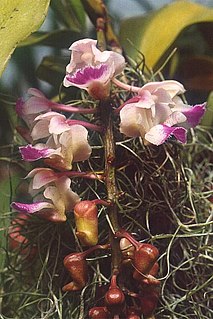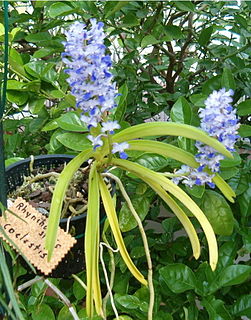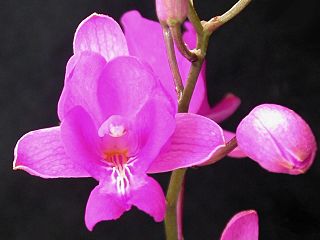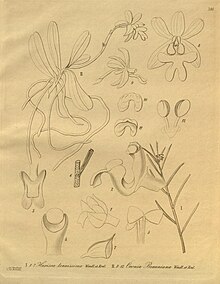
Orchidaceae, commonly called the orchid family, is a diverse and widespread family of flowering plants, with blooms that are often colourful and fragrant.

The Pleurothallidinae are a neotropical subtribe of plants of the orchid family (Orchidaceae) including 29 genera in more than 4000 species.

In the botanical classification of plants, Aeridinae is a subtribe of the tribe Vandeae whose representatives all have a monopodial growth habit and do not possess pseudobulbs.

Cypripedioideae is a subfamily of orchids commonly known as lady's slipper orchids, lady slipper orchids or slipper orchids. Cypripedioideae includes the genera Cypripedium, Mexipedium, Paphiopedilum, Phragmipedium and Selenipedium. They are characterised by the slipper-shaped pouches of the flowers – the pouch traps insects so they are forced to climb up past the staminode, behind which they collect or deposit pollinia, thus fertilizing the flower. There are approximately 165 species in the subfamily.

Ponerinae is a subfamily of ants in the Poneromorph subfamilies group, with about 1,600 species in 47 extant genera, including Dinoponera gigantea - one of the world's largest species of ant. Mated workers have replaced the queen as the functional egg-layers in several species of ponerine ants. In such queenless species, the reproductive status of workers can only be determined through ovarian dissections. Ponerinae is a subfamily of ants within the family of Formicidae. These ants typically nest in soil, forest litter, or rotting logs, and are predacious. They primarily prey on isopods. They mostly live in small colonies of up to 200 workers. They can be found mostly in tropical environments, but have been found in southeastern Canada and New York. Female workers have twelve segmented antennae, whereas male workers have 13 segmented antennae.

The Orchidoideae, or the orchidoid orchids, are a subfamily of the orchid family (Orchidaceae).

The Oncidiinae is a subtribe within the Orchidaceae that consists of a number of genera that are closely related.

Microtis, commonly known as onion orchids or mignonette orchids is a genus of about 20 species of plants in the orchid family, Orchidaceae. Onion orchids are terrestrial herbs with a single leaf at the base of the plant. They are similar to orchids in the genus Prasophyllum in that they have an onion-like leaf. The flowers are small but often scented and attractive to their insect pollinators. They are widespread in Asia, Australia and some Pacific islands.

Rhynchostylis is a genus in the orchid family (Orchidaceae), closely allied to the genus Vanda and comprising four currently accepted species native to the Indian Subcontinent, China, Indochina, Malaysia, Indonesia and the Philippines. The name consists of a compound of two Greek elements : rhynchos 'beak' and stylis 'column' – in reference to the very broad, fleshy column of the flower. The flowers are borne in dense racemes and are noted for their intense, spicy fragrance. Although lacking in pseudobulbs, the plants have leathery leaves that are drought-resistant. These orchids grow naturally in warm, moist, shaded tropical areas and will thrive in cultivation if given consistent warmth, uniform moisture and bright, but indirect light. Hobbyists wanting to grow them will need a warm, humid growing environment with gentle air movement. They can be grown in pots, but are better grown in baskets, owing to the extreme fleshiness of their roots. Their unusually fragrant blooms often appear in the slightly cooler winter months.

The Vandeae is a large monophyletic tribe within the family of orchids.

The tribe Epidendreae of the Orchidaceae comprises six subtribes:
Dendrobieae is a tribe in the subfamily Epidendroideae, in the family Orchidaceae.
Cranichideae is an orchid tribe in the subfamily Orchidoideae.
Orchideae is a tribe of orchids in the subfamily Orchidoideae. It has been divided into two subtribes, Orchidinae and Habenariinae. The subtribe Orchidinae alone contains about 1,800 species. However, although some phylogenetic studies have established the monophyly of the subtribes, the generic boundaries are unclear, with many genera as traditionally circumscribed being paraphyletic or even polyphyletic. Species of genera such as Habenaria and Platanthera have been placed into both subtribes. A 2017 molecular phylogenetic study found that both subtribes did form clades, but did not formally recognize Habenariinae, because of missing genera and uncertainty over generic boundaries. The Asian species of Orchideae, in particular, have been subject to repeated changes of generic placement from 2012 onwards.
Maxillariinae is an orchid subtribe in the tribe Cymbidieae. It was formerly treated as the tribe Maxillarieae, and divided into a number of subtribes.

Cyrtopone is an extinct genus of ants in the formicid subfamily Ponerinae described from fossils found in Europe. There are four described species placed into the genus, Cyrtopone curiosa, Cyrtopone elongata, Cyrtopone microcephala, and Cyrtopone striata. Cyrtopone is one several Lutetian Ponerinae genera.

Messelepone is an extinct genus of ants in the formicid subfamily Ponerinae described from fossils found in Europe. M. leptogenoides is the only species assigned to the genus, which is one of several Lutetian Ponerinae genera.
Mark Alwin Clements (b. 1949) is an Australian botanist and orchidologist. He obtained his doctorate at the Australian National University defending his thesis entitled Reproductive Biology in relation to phylogeny of the Orchidaceae, especially the tribe Diurideae.
Ondontomachini is a tribe of ants which belongs to the subfamily Ponerinae. Ondontomachini includes two genera: Odontomachus and Anochetus.













